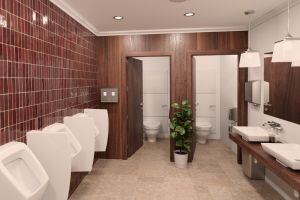Commercial Washroom Design Meets Domestic Comfort

April 11, 2025
As architectural design evolves, the division between commercial and residential spaces is starting to blur. Nowhere is this integration more evident than in modern washroom design, where the comfort and warmth of domestic settings is being incorporated into traditionally ‘sterile’ commercial facilities. This balance creates environments that maintain necessary durability and hygiene standards while offering users a more pleasant, less institutional experience.
Whether you’re a facility manager, business owner or fit-out company, in this blog you’ll benefit from guidance on how to create a more inviting yet still highly functional, commercial washroom space.
Combining Business Practicality with Domestic Comfort
Commercial washrooms traditionally prioritise practicality, durability, and ease of maintenance. However, contemporary design recognises that these spaces can significantly impact visitor experience and perception of an establishment. By incorporating elements of residential design, commercial washrooms become more inviting and can serve as an extension of a brand's identity.
For high-traffic environments such as hotels, restaurants, and office spaces, this balance creates washrooms that are designed for more than pure functionality — spaces that users genuinely appreciate rather than merely utilise.
Material Selection: Durability Without Compromising on Aesthetics
Stainless steel, long the cornerstone of commercial washroom fixtures, remains invaluable for its exceptional durability, resistance to corrosion, and ease of maintenance. However, contemporary applications demonstrate how this material can be implemented with greater sophistication.
Stainless Steel Reimagined
Modern manufacturing techniques have transformed stainless steel from purely functional to aesthetically versatile:
- Varied Finishes: Beyond traditional polished surfaces, brushed, powder-coated and architectural lacquers offer subtle visual interest while reducing fingerprints and water spots
- Thoughtful Integration: Recessed dispensers and cabinet-fronted combination units maintain cleanliness and save space, without visual disruption
When stainless steel elements are thoughtfully designed and precisely manufactured, they communicate quality and attention to detail while fulfilling their practical requirements—making them ideal components in the blended washroom concept.
Lighting: An Essential Element
Perhaps no single factor more dramatically influences the ambience of a washroom than lighting design. In the past, many commercial washrooms featured harsh, uniform overhead lighting that, while functional, created an unwelcoming atmosphere. Today's blended designs often incorporate layered lighting:
- Task Lighting: Focused illumination for specific functions like mirror use
- Ambient Lighting: Diffused general lighting that establishes overall brightness
- Accent Lighting: Strategic highlights that draw attention to design elements
Incorporating dimmable options and motion sensors further enhances efficiency while allowing for lighting adjustments according to time of day or occupancy levels.
Furniture Integration: Beyond Basic Fixtures
Traditional commercial washrooms rarely feature furniture beyond the essential fixtures. Contemporary blended designs, however, recognise the value of thoughtfully selected furnishings, such as:
- Vanity Areas: Countertop spaces that accommodate personal items during use
- Seating: Small benches or stools that provide convenience in larger washrooms
- Shelving Integration: Practical storage for consumables that eliminates clutter while offering convenience for the cleaning team
- Modular Systems: Flexible components that can be reconfigured as needs change – such as the Modulo Slimline Behind the Mirror Cabinet, which incorporates your choice of dispensers into a complete hand hygiene system.
These elements enhance the space from purely functional to genuinely comfortable.
Implementing a Blended Commercial Washroom Design
Implementing this blended approach requires consideration of several factors:
1. Prioritise Maintenance Requirements
While aesthetic considerations are important, maintenance practicality remains paramount. Specify materials and designs that:
- Resist water damage & corrosion
- Clean easily with standard protocols
- Feature replaceable components
2. Consider Traffic Patterns
Design choices should reflect anticipated usage levels. High-traffic environments require more robust solutions than spaces with limited use. Well-designed traffic flow prevents crowding and maintains privacy while accommodating peak usage periods.
Unsure how many washroom dispensers you need? The minimum number of toilet stalls you need is regulated in the UK. This number can help you determine the number of dispensers required. Find out more in our guide.
3. Address Accessibility Requirements
Inclusive design ensures all users have comparable experiences. Beyond meeting regulatory standards, thoughtfully designed accessible features can integrate seamlessly with the overall aesthetic rather than appearing as afterthoughts.
4. Maintain Hygiene Standards
The COVID-19 pandemic heightened awareness of hygiene in shared spaces. Touchless fixtures, antimicrobial surfaces, and adequate ventilation remain essential components of any contemporary washroom design.
Integrating Commercial Durability with Residential Warmth
The thoughtful integration of commercial durability with residential warmth creates washroom environments that truly serve users' needs—both practical and psychological. When designed with care, these aesthetically pleasing spaces communicate an organisation's attention to detail and consideration for user experience.
At Dudley Industries, our extensive range includes elegantly designed dispensers, waste receptacles and modular systems that seamlessly blend durability with aesthetics. Our washroom products are crafted from the highest quality stainless steel for distribution to companies across the globe. Discover how Dudley Industries’ range of washroom equipment can become the cornerstone of your blended washroom environment today.